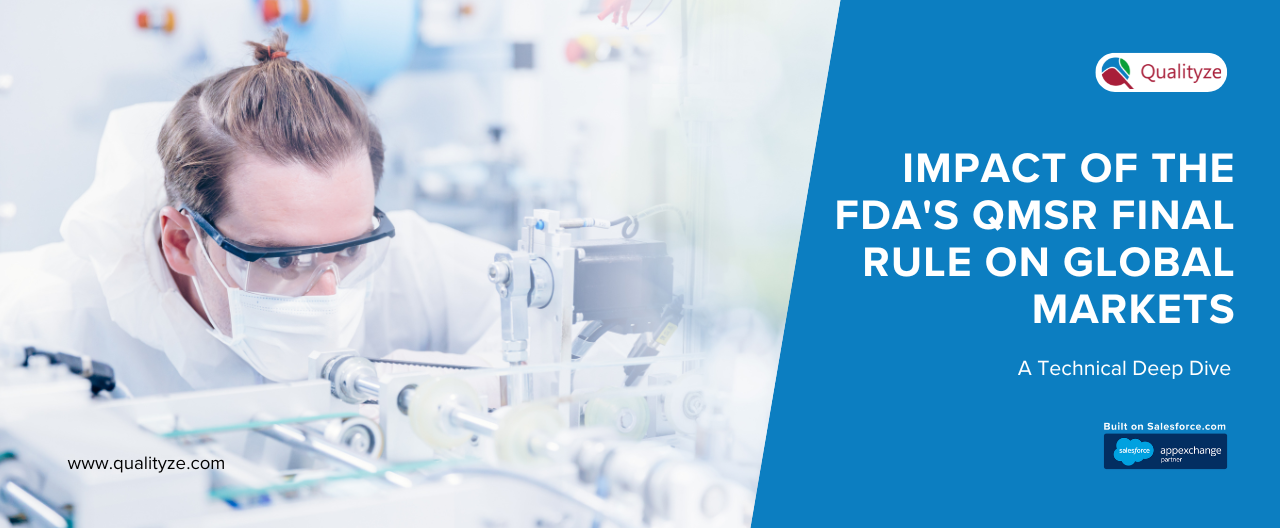Calculate your potential savings with our ROI Calculator
ROI CalculatorCalculate your potential savings with our ROI Calculator
ROI Calculator1 What is the Final Rule of the FDA on QMSR?
Key Objectives of the QMSR Final Rule:
3 Transition Period for the QMSR:
Transition Timeline:
5 FDA's Current Regulatory Framework:
Limitations of 21 CFR Part 820:
7 Timeline for QMSR Implementation:
8 Major Changes Between the Proposed Rule and Final Rule for QMSR:
Key Consistencies:
10 Key Components of QMSR Final Rule:
11 When Will the New QMSR Regulation Be Effective?
12 Impact on Medical Device Manufacturers in the United States:
Specific Areas of Impact:
14 How to Prepare for the FDA's QMSR:
15 Leveraging AI-powered Qualityze EQMS Suite for QMSR Compliance
16 The Final Note:
Key Takeaways:

The global medical device market is undergoing a significant shift, with the implementation of the final rule of the Quality Management System Regulation (QMSR) by the US FDA. This landmark regulation aims to harmonize US standards with the international norm, ISO 13485:2016, fostering a more streamlined and globally recognized approach to ensure the safety and efficacy of medical devices. This blog will help you understand the specific requirements of the QMSR, exploring its impact on manufacturers worldwide, key components of the regulation, and crucial steps companies should take for a smooth transition.
The FDA's final rule on the Quality Management System Regulation (QMSR) represents a significant shift in the regulatory standards for medical devices in the United States. A QMS is a formally defined system to document processes, procedures, and responsibilities that help achieve quality objectives in alignment with standard policies. The primary purpose of the QMSR final rule is to harmonize US regulations with the international standard ISO 13485:2016. This alignment aims to streamline regulatory requirements, enhance global market integration, and improve product quality and patient safety.
The rule incorporates key aspects of ISO 13485 into 21 CFR Part 820, previously known as the Quality System Regulation (QSR). This transition is expected to reduce the regulatory burden on manufacturers and create a more predictable regulatory environment.
The FDA has provided a two-year transition period for manufacturers to comply with the QMSR, effective February 2, 2026. This period allows manufacturers ample time to adjust their quality management systems and processes to meet the new requirements.
During this transition period, the FDA will offer guidance and support to help manufacturers understand and implement the new requirements effectively.
Before the implementation of the QMSR, 21 CFR Part 820 governed the FDA's regulatory framework for medical devices, commonly known as the Quality System Regulation (QSR). The QSR outlines the key requirements for quality management systems governance in the medical devices industry. However, the QSR had certain limitations in aligning with global standards, which posed challenges for manufacturers operating in multiple markets.
Related Article - Looking beyond the horizon: A practical approach to Deviation Management
The new QMSR addresses these limitations by harmonizing with ISO 13485, facilitating smoother international operations, and reducing the compliance burden.
The FDA's implementation process for the QMSR involves several key milestones:
During this period, manufacturers are encouraged to engage with the FDA and industry associations to ensure a smooth transition while complying with the new standards.
The final rule for the Quality Mangement System Regulation (QMSR) largely reflects the proposed version with minimal modifications. The core elements and objectives remain consistent, ensuring a smooth transition for manufacturers who have been preparing based on the proposed rule. Any changes between the proposed and final versions are typically minor clarifications or adjustments to address stakeholder feedback.
The FDA's decision to maintain consistency between the proposed and final rules provides clarity and predictability for manufacturers, facilitating a smoother implementation process.
Related Article : How to Comply with FDA 21 CFR Part 820
The QMSR final rule encompasses several critical components designed to enhance product quality and patient safety:
The new QMSR regulation will be effective on February 2, 2026. This effective date gives manufacturers a clear deadline for achieving compliance and sufficient time for the necessary adjustments.
The impact of the QMSR on US manufacturers will vary based on their existing compliance status:
To ensure compliance with the QMSR, manufacturers should take the following actionable steps:
In the wake of the FDA's QMSR final rule, medical device manufacturers can significantly benefit from advanced technological solutions such as the AI-powered Qualityze Enterprise Quality Management System (EQMS) Suite. Qualityze EQMS Suite offers a comprehensive, cloud-based platform to streamline and improve quality management processes. By leveraging artificial intelligence, the suite can help manufacturers efficiently manage compliance with the QMSR requirements. The AI-driven analytics and automation capabilities facilitate proactive risk management by predicting potential quality issues and providing actionable insights. The Qualityze EQMS Suite also ensures robust documentation and recordkeeping, enabling manufacturers to maintain detailed, accurate, and easily retrievable records. This is crucial for demonstrating compliance during audits. The suite's supplier quality management module helps monitor and manage supplier performance, ensuring that all materials and components meet regulatory standards. With built-in workflows and real-time reporting, Qualityze EQMS Suite supports continuous improvement and adherence to the new QMSR standards, ultimately fostering a culture of quality and compliance within the organization.
Related Article: Key Differences between ISO 13485 and ISO 9001 for Medical Devices
The FDA's QMSR final rule represents a significant step towards global regulatory harmonization. By aligning with ISO 13485, the QMSR facilitates smoother international operations and ensures a higher quality standard for medical devices. Manufacturers must prepare early to ensure a seamless transition and maintain market access.